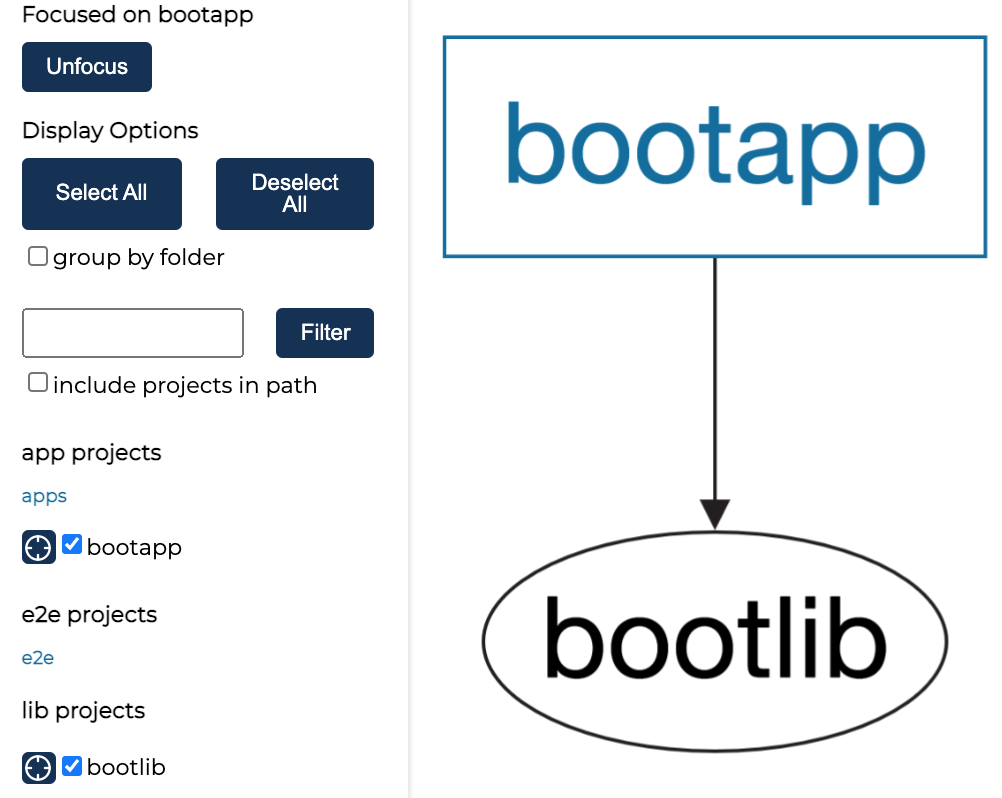Nx Plugin to generate, run, package, build (and more) Spring Boot projects inside your Nx workspace
Here is a list of some of the coolest features of the plugin:
-
✅ Generation of Spring Boot applications/libraries based on Spring Initializr API
-
✅ Building, packaging, testing, etc your Spring Boot projects
-
✅ 🆕 Built-in support for creating multi-modules Spring Boot projects with both
MavenandGradle -
✅ Built-in support for code formatting using the excellent Spotless plugin for
MavenorGradle -
✅ Built-in support for corporate proxies (either via
--proxyUrlor by defining environment variablehttp_proxy,HTTP_PROXY,https_proxyorHTTPS_PROXY) -
✅ Integration with Nx's dependency graph (through
nx graphornx affected:graph): this allows you to visualize the dependencies of any Spring Boot'sMaven/Gradleapplications or libraries inside your workspace, just like Nx natively does it for JS/TS-based projects! Example of running the
Example of running the nx graphcommand on a workspace with 2 Spring Boot projects inside -
...
📢 ℹ️ 🆕 HEADS UP! New simplified setup since October 2023, with our custom CLI!
You can now use our own
create-nx-spring-bootCLI to easily create a Nx workspace, that comes with this plugin pre-installed!Simply run:
# npm npx create-nx-spring-boot@latest # or # yarn yarn create nx-spring-bootand you are good to go‧o‧o‧o! 🚀
More information here: create-nx-spring-boot
Otherwise, this is the traditional way of setting things up:
If you have not already, create an Nx workspace with the following:
# npm
npx create-nx-workspace@latest
# yarn
yarn create nx-workspace
Then you need to install the plugin in order to generate Spring Boot applications later on.
# npm
npm install @nxrocks/nx-spring-boot --save-dev
# yarn
yarn add @nxrocks/nx-spring-boot --dev
This plugin is composed of 2 main generators:
projectgeneratorlinkgenerator
Simply run the project generator with the following command:
nx g @nxrocks/nx-spring-boot:project <your-app-name>
you can also use the following aliases to call the generator:
proj,new, orcreate
You will be prompted for entering the most commonly customized generation options (like project's groupId, artifactId, packaging, dependencies, etc).
To skip the interactive prompt, or if you want to customize all non-prompted options, you can pass them along directly when running the command, as such:
nx g @nxrocks/nx-spring-boot:project <your-app-name> --optionName1 optionValue1 ... --optionNameN optionValueN
Here the list of available generation options :
| Arguments | Description |
|---|---|
<name> |
The name of your project. |
| Option | Value | Description |
|---|---|---|
projectType |
application | library |
Type of project to generate |
buildSystem |
maven-project | gradle-project |
Build system |
packaging |
jar | war |
Packaging to use |
javaVersion |
8 | 11 | 15 |
Java version to use |
language |
java | groovy | kotlin |
Language to use |
groupId |
string |
GroupId of the project |
artifactId |
string |
ArtifactId of the project |
packageName |
string |
Main package name |
description |
string |
Description of the project |
skipFormat |
boolean |
Do not add the ability to format code (using Spotless plugin) |
dependencies |
string |
List of dependencies to use (comma-separated). Go to recipes for more information |
transformIntoMultiModule |
boolean |
Transform the project into a multi-module project. Go to recipes for more information |
addToExistingParentModule |
boolean |
Add the project into an existing parent module project. Go to recipes for more information |
parentModuleName |
string |
Name of the parent module to create or to add child project into. Go to recipes for more information |
keepProjectLevelWrapper |
boolean |
Keep the Maven or Gradle wrapper files from child project (when generating a multi-module project). Go to recipes for more information |
springInitializerUrl |
https://start.spring.io |
URL to the Spring Initializer instance to use |
proxyUrl |
The URL of the (corporate) proxy server to use to access Spring Initializr | |
bootVersion |
string |
Spring Boot version to use |
tags |
string |
Tags to use for linting (comma-separated) |
directory |
string |
Directory where the project is placed |
Note: If you are working behind a corporate proxy, you can use the
proxyUrloption to specify the URL of that corporate proxy server. Otherwise, you'll get a ETIMEDOUT error when trying to access official Spring Initializer to generate the project. Even simpler, you can just define environment variablehttp_proxy,HTTP_PROXY,https_proxyorHTTPS_PROXYglobally.
This generator is used to link a Spring Boot project inside the workspace (the source project) with another project (the target project), by adding the source project as an implicit dependency of the later.
Simply run the link generator with the following command:
nx g @nxrocks/nx-spring-boot:link
you can also use the following aliases to call the generator:
link-project
You will be prompted for entering the most commonly customized generation options (sourceProjectName, targetProjectName).
To skip the interactive prompt, you can pass options along directly when running the command, as such:
nx g @nxrocks/nx-spring-boot:link --sourceProjectName <your-boot-app> --targetProjectName <your-other-app>
or even simpler:
nx g @nxrocks/nx-spring-boot:link <your-boot-app> <your-other-app>
Here the list of available generation options :
| Arguments | Description |
|---|---|
<sourceProjectName> |
The name of the source(Spring-Boot) project to link from. 1st argument of the link generator. Can also be provided as option --sourceProjectName |
<targetProjectName> |
The name of the target project to link to. 2nd argument of the link generator. Can also be provided as option --targetProjectName |
Once your app is generated, you can now use executors to manage it.
Here the list of available executors:
| Executor | Arguments | Description |
|---|---|---|
run | serve* |
ignoreWrapper:boolean, runFromParentModule:boolean, args: string[] |
Runs the project using either ./mvnw|mvn spring-boot:run or ./gradlew|gradle bootRun |
test |
ignoreWrapper:boolean, runFromParentModule:boolean, args: string[] |
Tests the project using either ./mvnw|mvn test or ./gradlew|gradle test |
clean |
ignoreWrapper:boolean, runFromParentModule:boolean, args: string[] |
Cleans the project using either ./mvnw|mvn clean or ./gradlew|gradle clean |
format |
ignoreWrapper:boolean, runFromParentModule:boolean, args: string[] |
Format the project using Spotless plugin for Maven or Gradle |
check-format |
ignoreWrapper:boolean, runFromParentModule:boolean, args: string[] |
Check whether the project is well formatted using Spotless plugin for Maven or Gradle |
build |
ignoreWrapper:boolean, runFromParentModule:boolean, args: string[] |
Packages the project into an executable Jar using either ./mvnw|mvn package or ./gradlew|gradle build |
install |
ignoreWrapper:boolean, runFromParentModule:boolean, args: string[] |
Installs the project's artifacts to local Maven repository (in ~/.m2/repository) using either ./mvnw|mvn install or ./gradlew|gradle publishToMavenLocal |
build-info* |
ignoreWrapper:boolean, runFromParentModule:boolean, args: string[] |
Generates a build-info.properties using either ./mvnw|mvn spring-boot:build-info or ./gradlew|gradle bootBuildInfo |
build-image* |
ignoreWrapper:boolean, runFromParentModule:boolean, args: string[] |
Generates an OCI Image using either ./mvnw|mvn spring-boot:build-image or ./gradlew|gradle bootBuildImage |
In order to execute the requested command, each executor will use, by default, the embedded ./mvnw or ./gradlew executable, that was generated alongside the project.
If you want to rely on a globally installed mvn or gradle executable instead, add the --ignoreWrapper option to bypass it.
This can be useful in a CI environment for example, or in a restricted environment where the binary cannot be downloaded (due to proxy/firewall limitations).
nx run your-boot-app:run
// or its shorter alias
nx serve your-boot-app
You can pass in additional arguments by editing the related section in the workspace.json file, as such:
{
"version": 1,
"projects": {
"you-boot-app": {
"projectType": "application",
"root": "apps/you-boot-app",
"sourceRoot": "apps/you-boot-app/src",
"targets": {
"run": { // or "serve", according to your preference
"executor": "@nxrocks/nx-spring-boot:run",// or "@nxrocks/nx-spring-boot:serve", according to your preference
"options": {
"root": "apps/you-boot-app",
"args": ["arg1", "arg2"]
}
}
}
}},
"cli": {
"defaultCollection": "@nx/workspace"
}
}nx build your-boot-app
Note: a task dependency to
installexecutor of dependent (library) projects is added by the plugin, so that Nx will automaticallyinstalldependent artifacts to your local Maven repository, prior to running this command. This is particulaly useful, when for example, you have a Spring Boot application that depends on another Spring boot library in the workspace. No more need to install the library yourself first!
Install the project's artifacts to local Maven repository (in ~/.m2/repository) - (install Executor)
nx install your-boot-app
nx build-image your-boot-app
You can pass in additional arguments by editing the related section in the workspace.json file, as such:
{
"version": 1,
"projects": {
"you-boot-app": {
"projectType": "application",
"root": "apps/you-boot-app",
"sourceRoot": "apps/you-boot-app/src",
"targets": {
"build-image": {
"executor": "@nxrocks/nx-spring-boot:build-image",
"options": {
"root": "apps/you-boot-app",
"args": [
"--executor=gcr.io/paketo-buildpacks/executor:base-platform-api-0.3",
"--runImage=my-image"
]
}
}
}
}
},
"cli": {
"defaultCollection": "@nx/workspace"
}
}nx test your-boot-app
nx clean your-boot-app
nx run your-boot-app:format
// or simply
nx apply-format your-boot-app
Note: You *cannot** use the shorter
nx format your-boot-appsyntax here, because that would conflict with the nativeformatcommand from Nx CLI.
nx check-format your-boot-app
Every Nx plugin relies on the underlying Nx Workspace/DevKit it runs on. This table provides the compatibility matrix between major versions of Nx workspace and this plugin.
| Plugin Version | Nx Workspace version |
|---|---|
>=v10.x.x |
>=v18.x.x |
>=v9.x.x |
>=v17.x.x |
>=v8.x.x |
>=v16.x.x |
>=v7.x.x |
>=v15.8.x |
>=v6.x.x |
>=v15.x.x |
>=v4.x.x |
>=v13.8.x |
>=v3.x.x |
>=v12.6.x |
>=v2.x.x |
>=v11.x.x |
<=v1.3.1 |
<=v10.x.x |
Copyright (c) 2020-present Tine Kondo. Licensed under the MIT License (MIT)



